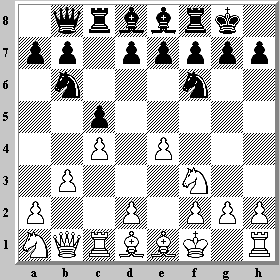After a few days play, a game starting NQRBBKNR (SP217) and continuing 1.Nf3 c5 2.c4 Nb6 3. b3 Nf6 4. e4 O-O reaches the following position
Black
White
(After 4...O-O)
Now White timidly asks Black, 'Can you tell me, please, how can I castle? It's enough to move the king to g1 or there's something else I should do?'. Black's first reaction must have been, 'What the...? How did this guy survive the first five rounds, two games per round, without knowing the rules of castling?' The second reaction might have been, 'Now I get it! He doesn't know how to execute the castling move on Scheming Mind', followed by the same refrain, 'How did this guy survive the first five rounds without knowing the mechanics of castling?'
I looked at White's previous games in the tournament and verified that he had never castled. Game after game, with the King stuck in the center and a Rook out of play, White must have been an exceptionally good defensive player to have faced increasingly skilled competition without ever castling.
When castling in traditional chess, most software works the same way. You click on the King, then click the square located two squares toward the castling Rook. The software understands your intention exactly and moves both the King and the Rook to their castled squares.
In chess960, the castling intention is not so straightforward. Sometimes both pieces move, sometimes only the King moves, and sometimes, most illogically for traditional chess players, only the Rook moves. How to tell the software that, for example, clicking on the Rook this time means castling, but next time means a normal Rook move? There is no standard way to do this and the mechanism for castling depends on the software being used.
Before you play chess960 using new software or on a new site, make sure you know how to execute a castling move. Take the time (for once?) to read the instructions. Later in your games, it will save you much defensive maneuvering and perhaps a little embarrassment.

No comments:
Post a Comment